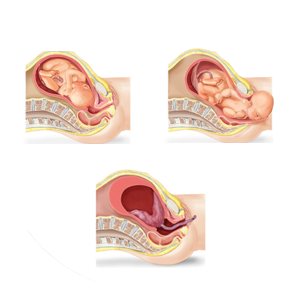LABOR
Onset of labor, the first stage, is signaled by contractions of the uterus felt as cramplike pains in the abdomen or lower back that recur at regular intervals of 10 to 30 minutes and last about 40 seconds; they increase in frequency until they occur at about 2-minute intervals. With each contraction the cervix, or neck of the uterus, dilates until it becomes wide enough, about 4 in. (10 cm), to permit emergence of the baby.
Contractions begin and become more regular as your cervix begins to dilate (open) and efface (thin out). Most women are able to spend this time at home. This stage usually takes anywhere from about two to 24 hours, and by the end of it, your cervix is between four and six centimeters dilated.
Active Labor
You're now beginning to really feel those contractions, which are about three to five minutes apart and last for 30 seconds or more. This is the time when you should be on your way to the hospital.
Your contractions are likely quite painful at this point, and it's important to remember that this pain is not a sign that anything is wrong. In fact, it means everything is coming along as it should. It's a natural reaction to tense up in times of pain or worry, but doing so actually creates more work for your body and makes labor more difficult. There are lots of ways to cope — an epidural or pain medication, a Jacuzzi bath, music, movement, an internal or external focus point, or breathing techniques.
Active labor usually lasts between four and eight hours, although it can be longer or shorter. This phase tends to go faster if you're getting Pitocin to induce or speed up labor, or you've already had a vaginal birth. It can be slower if you have an epidural.
Transition
Near the end of active labor is a time called transition, where your cervix opens from seven to a full 10 centimeters. It's a short but intense time, when contractions are quite strong, coming every two to three minutes and lasting a minute or longer. You may be shivering and shaking, alternating between feeling too hot and too cold, and feel nauseated or even vomit. This phase can last a few minutes or a few hours, and is usually faster if you've already had a vaginal birth.
In the second stage of labor the baby passes through the birth canal, most commonly head first, and is born. The effectiveness of uterine contractions in this stage is enhanced by the bearing-down abdominal contractions of the mother.
At the end of transition, once your cervix has reached 10 centimeters dilation, you're ready to begin pushing. You'll feel some pressure as if you need to have a bowel movement, followed by the urge to push. If you've had an epidural you may not feel as strong an urge (if any), and you can watch your contractions on the monitor to know when to push. At this point, your doctor or midwife will be your coach, telling you when it's time to push or ease back (to decrease the chance of tearing). This phase can last a few minutes or a few hours. It's generally on the longer end with an epidural and on the shorter end with a prior vaginal birth.
As your baby's head starts to crown, you'll feel the so-called "ring of fire," and as your baby's head emerges, her airways will be cleared. After she's all the way out, and if everything went according to plan, she'll be lifted up onto your chest for her very first hug.
The good news is that the hard part is over. This final stage is just a few contractions to separate the placenta from the uterine wall, followed by a short and painless push. It takes from a few minutes to about half an hour. Your provider will check to make sure the entire placenta is out, and if you tore or had an episiotomy, she'll suture it up.
The third stage of labor, which occurs about 15 to 30 minutes after the child is born, is characterized by the separation of the placenta from the uterine wall and its expulsion. The total time of labor averages 13 to 14 hours in women pregnant for the first time and 8 to 9 hours in women who have previously borne children.
After delivering the placenta, your uterus will begin to tighten up and feel hard, which helps contract all the blood vessels and control bleeding. You may be given some Pitocin to help it along. You might feel some contractions that feel like menstrual cramps for some time after the birth, especially if you've had a baby before. Your provider can give you pain relievers if they bother you.
If you had an epidural, a nurse will remove the catheter from your back, which takes just a minute and is painless.
 Every labor is unique, even if the mother is the same. Labor is a natural part of the birthing process, in which there are three main stages each woman has to go through. Some labors come and go within hours, while others take more or less time.
Every labor is unique, even if the mother is the same. Labor is a natural part of the birthing process, in which there are three main stages each woman has to go through. Some labors come and go within hours, while others take more or less time.